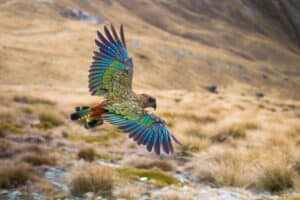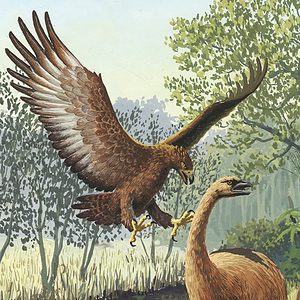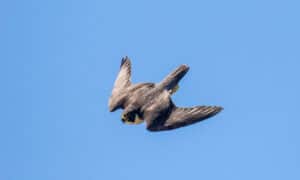South Carolina lies in the coastal Southeast and is known for its beach tourism, historic districts, and golfing destinations. The state features a humid subtropical climate and has three main regions consisting of coastal plains, the Blue Ridge Mountains, and the Piedmont. Its climate and geography provide suitable habitats for many animals, including birds. Discover 13 blue birds in South Carolina here:
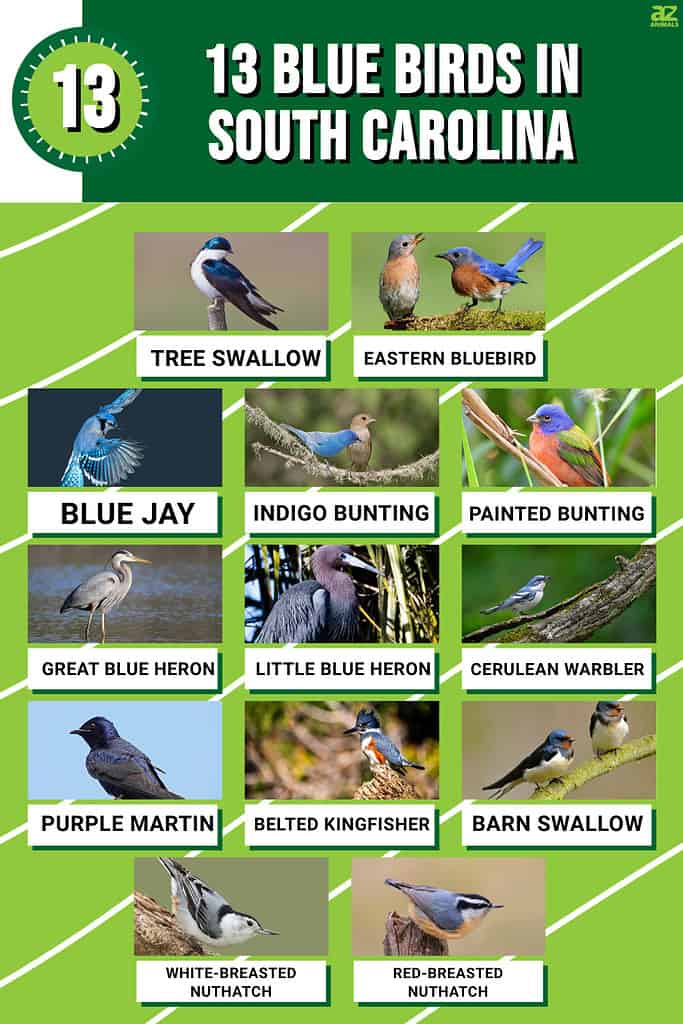
Read on to learn about their migration, habitats, appearance, vocalizations, and nests.
1. Tree Swallow
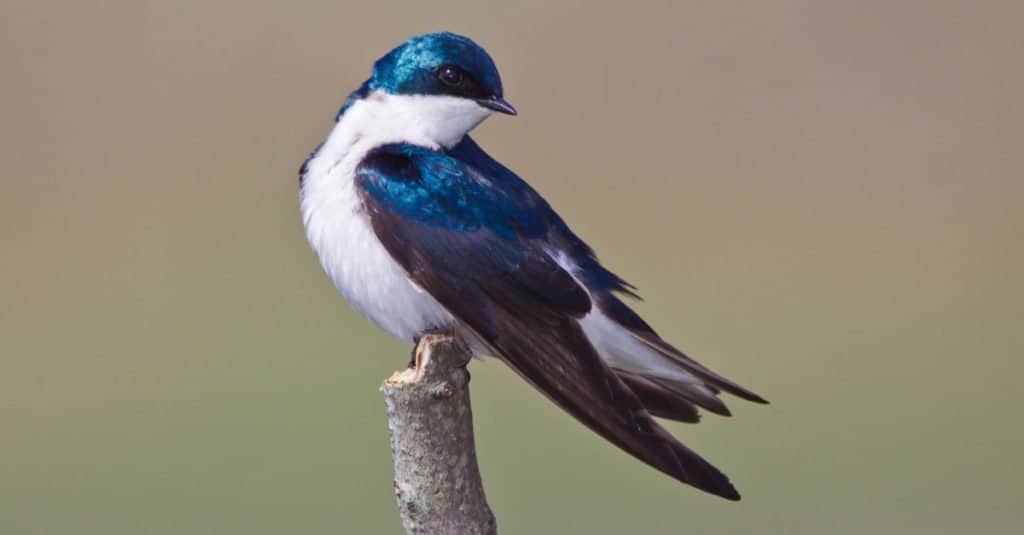
Tree swallows winter along the South Carolina coast and migrate through the rest of the state.
©Elliotte Rusty Harold/Shutterstock.com
Migration and Habitat: Tree swallows spend their winters along the South Carolina coast and migrate through the rest of the state. They will be in open or semi-open areas, such as fields, meadows, and marshes.
Features and Coloring: These birds have long, pointed wings and short, notched tails. Their coloring is blue-green above and white below, with dark brown, almost black wings and tails.
Food: They eat insects and berries.
Vocalizations: They emit three high-pitched sounds: chirp, whine, and gurgle.
Nests: They make a grass cup in a dead tree hole.
2. Eastern Bluebird
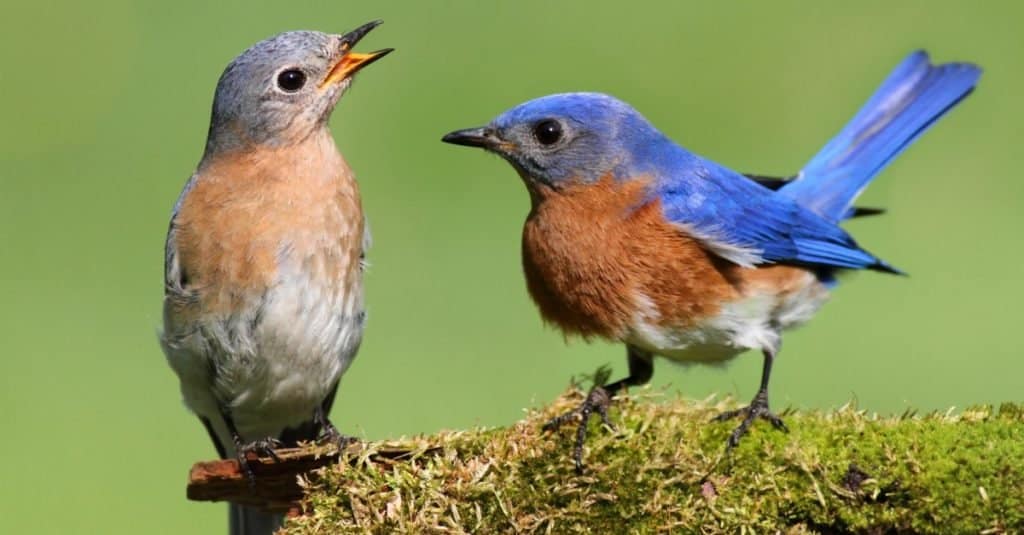
The
eastern bluebird
is a permanent resident of the Southeast, including South Carolina.
©Steve Byland/Shutterstock.com
Migration and Habitat: Eastern bluebirds are permanent residents in South Carolina and throughout most of the Southeast. They prefer to live in open country near tree cover, like pastures, fields, golf courses, and parks.
Features and Coloring: This species has long wings and a round head with large eyes. The male eastern bluebird has bright blue plumage above and white below with brownish-red breasts.
Food: They consume insects and berries.
Vocalizations: They make soft, low-pitched warbles and calls.
Nests: They nest in a tree cavity lined with grasses and weeds.
3. Blue Jay
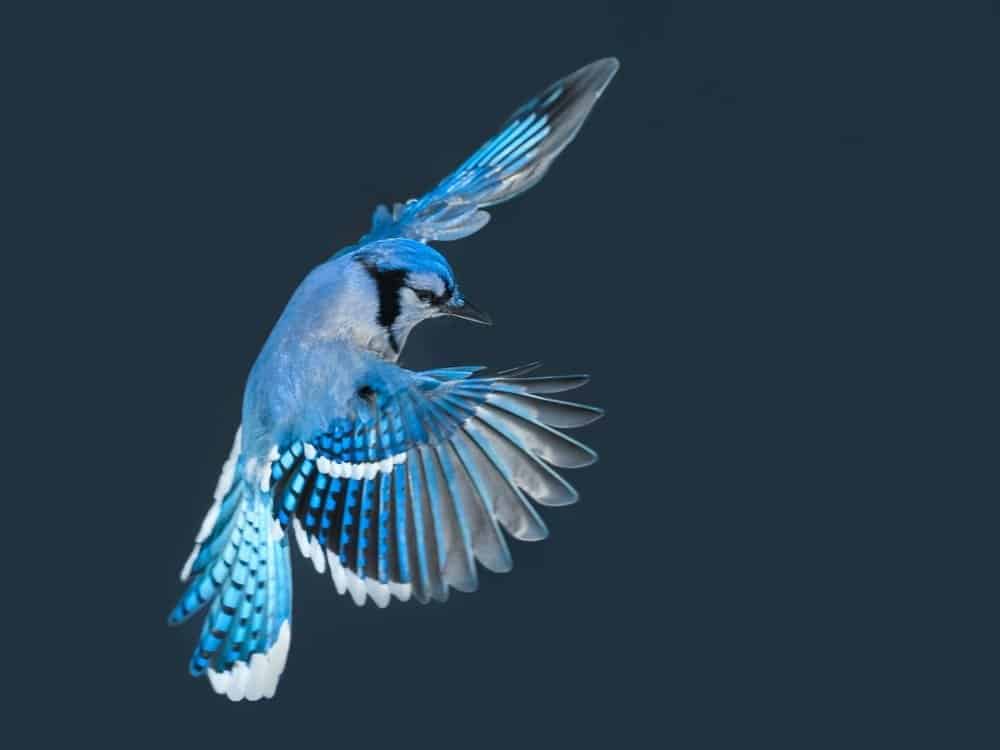
Blue jays are permanent residents of the East and are abundant in forests with oak trees.
©FotoRequest/Shutterstock.com
Migration and Habitat: Blue jays live year-round in South Carolina and the rest of the East. This species is abundant in forests, especially in oak trees near the forest edge. You will also spot them in common areas near urban and suburban settings.
Features and Coloring: They feature prominent crests and long tails. Their plumage is a mixture of various blue shades, white, and black.
Food: Nuts, grains, berries, seeds, fruits, and insects make up their diet.
Vocalizations: Their calls are whispering clicks and whines.
Nests: A bulky twig cup in a tree fork is used as a nest.
4. Indigo Bunting
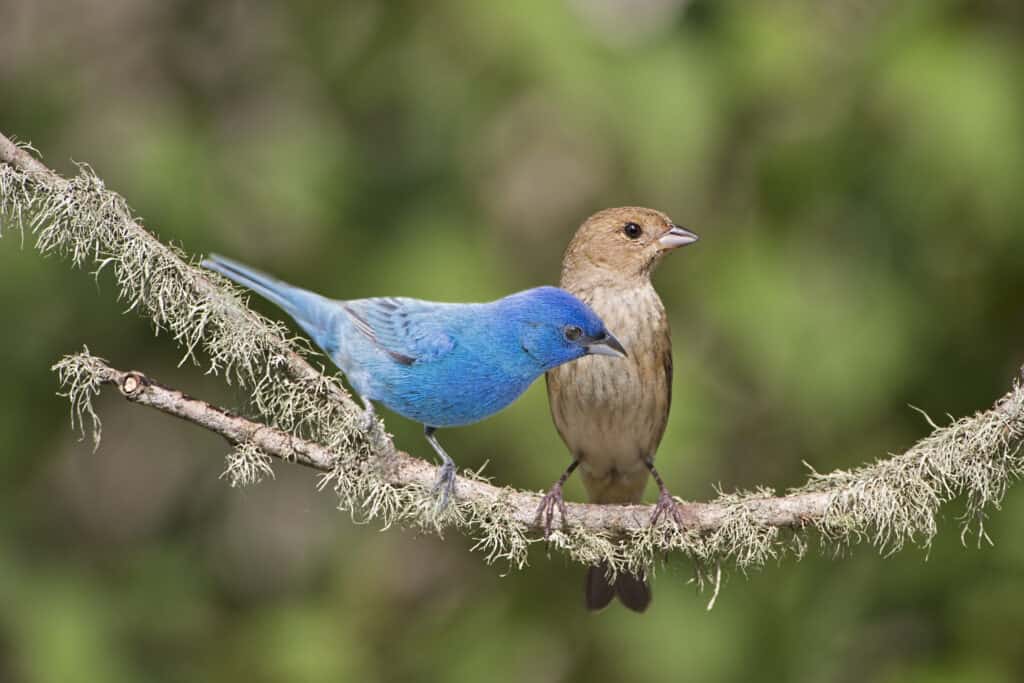
The indigo bunting is a breeder in South Carolina and throughout the East.
©Bonnie Taylor Barry/Shutterstock.com
Migration and Habitat: The indigo bunting breeds throughout South Carolina and most of the Eastern United States. They place their nests in brushy and weedy areas, like wood edges.
Features and Coloring: They have short tails and conical bills and the males feature bright blue feathers all over, in the summer, with darker heads and silver beaks. In the winter, the males are brown like the female indigo buntings.
Food: Seeds and insects make up their diet.
Vocalizations: They sing bright, high-pitched notes.
Nests: They build open grass cups in dense shrubs.
5. Painted Bunting
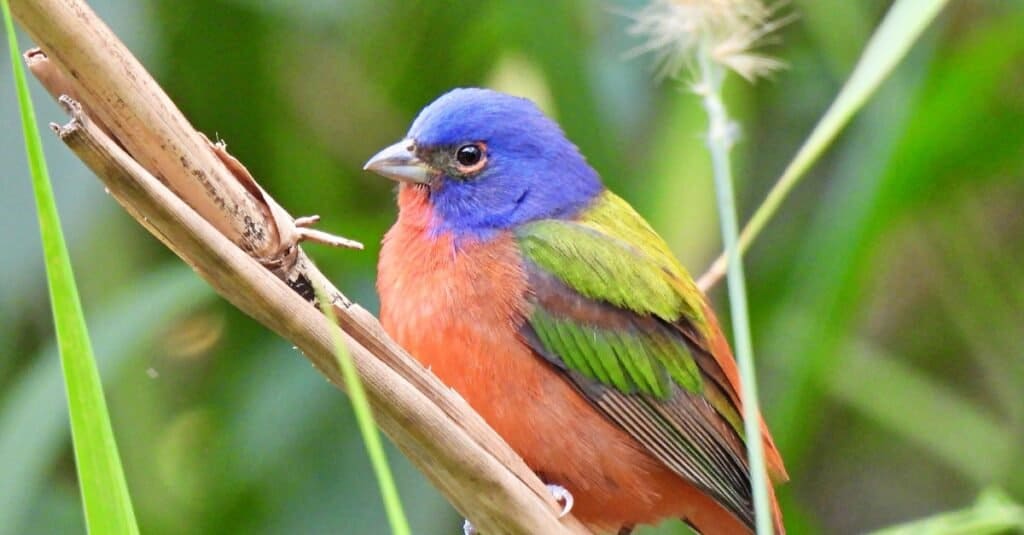
The painted bunting lives along the South Carolina coast during spring and summer.
©iStock.com/passion4nature
Migration and Habitat: Painted buntings breed along the South Carolina coast before heading to Southern Florida for the winter. They prefer semi-open habitats with scattered trees for breeding. Look for them in scrub and palmetto thickets.
Features and Coloring: They have long tails and thick bills. Their plumage is vivid and colorful, featuring blue, red, orange, and green.
Food: Seeds and insects are their favorite foods.
Vocalizations: They emit short musical notes.
Nests: Woven grass cups in dense bushes make a good nest.
6. Great Blue Heron
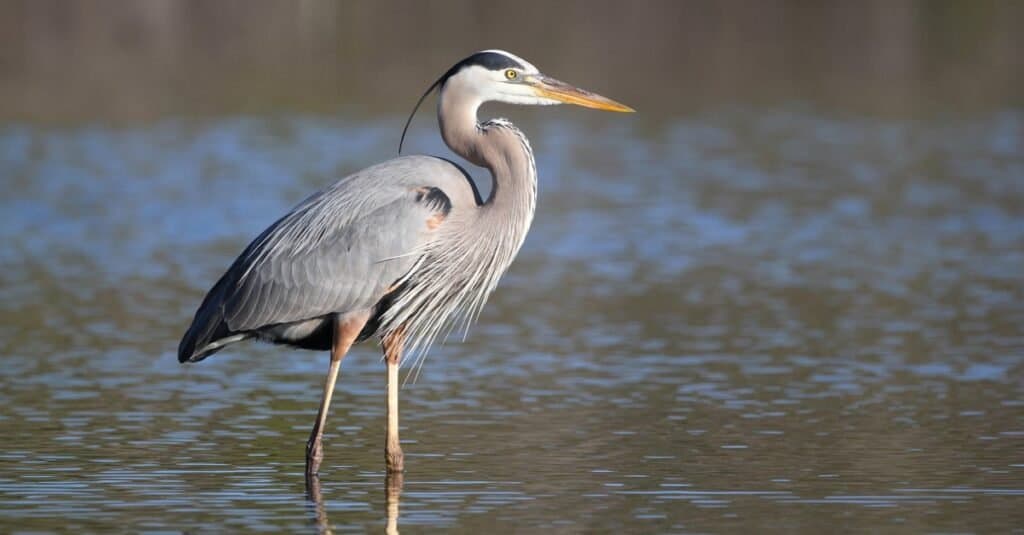
Great blue herons live year-round in the state in freshwater and saltwater habitats.
©Brian Lasenby/Shutterstock.com
Migration and Habitat: The great blue heron is a permanent resident in South Carolina and across much of the United States, especially near southern coasts. They live in both freshwater and saltwater habitats, like swamps and marshes.
Features and Coloring: They have very long legs and necks and dark eye stripes. Their plumage is overall bluish-gray and white.
Food: Fish, amphibians, snakes, and insects make up their meals.
Vocalizations: They make sounds like squawking and clucking.
Nests: This species builds stick platforms in trees.
7. Little Blue Heron
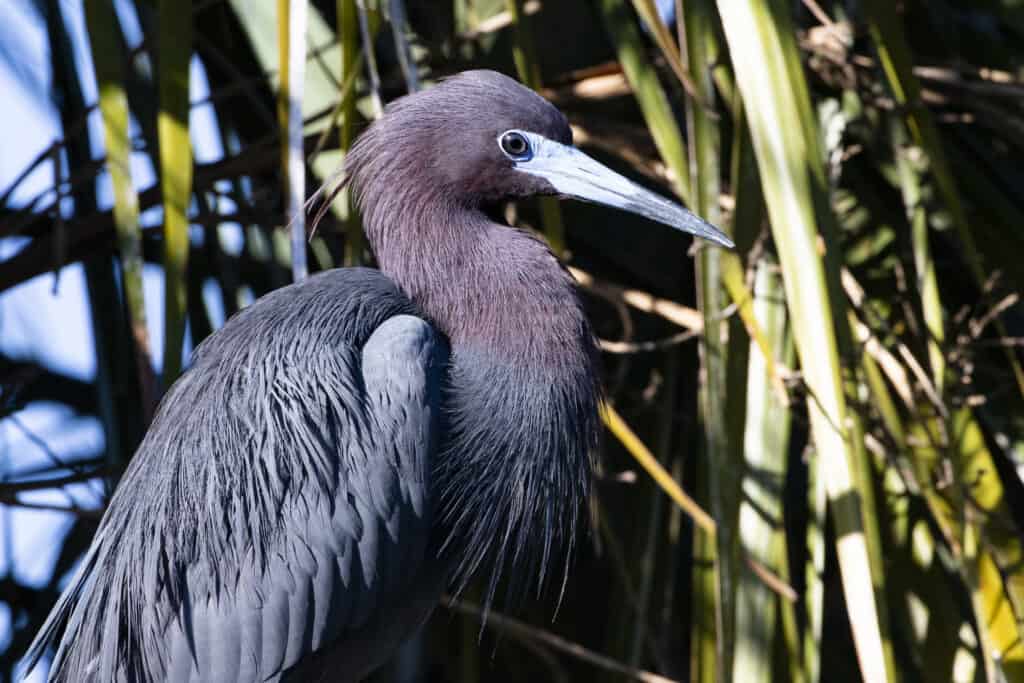
The little blue heron lives along the coast in marshes and swamps year-round. You can also find them in tide flats and lagoons.
©iStock.com/Florence and Joseph McGinn
Migration and Habitat: Little blue heron populations along the South Carolina coast stay there year-round, and those further inland live there during the breeding season. These birds stay near tide flats, marshes, swamps, lagoons, and other wetland habitats.
Features and Coloring: This species has long legs and necks but it’s smaller than the great blue. They are dark grayish-blue and maroon.
Food: Fish and crustaceans make up the bulk of their diet.
Vocalizations: They release hoarse croaks and bill snapping.
Nests: They nest in stick platforms in trees or shrubs.
8. Cerulean Warbler
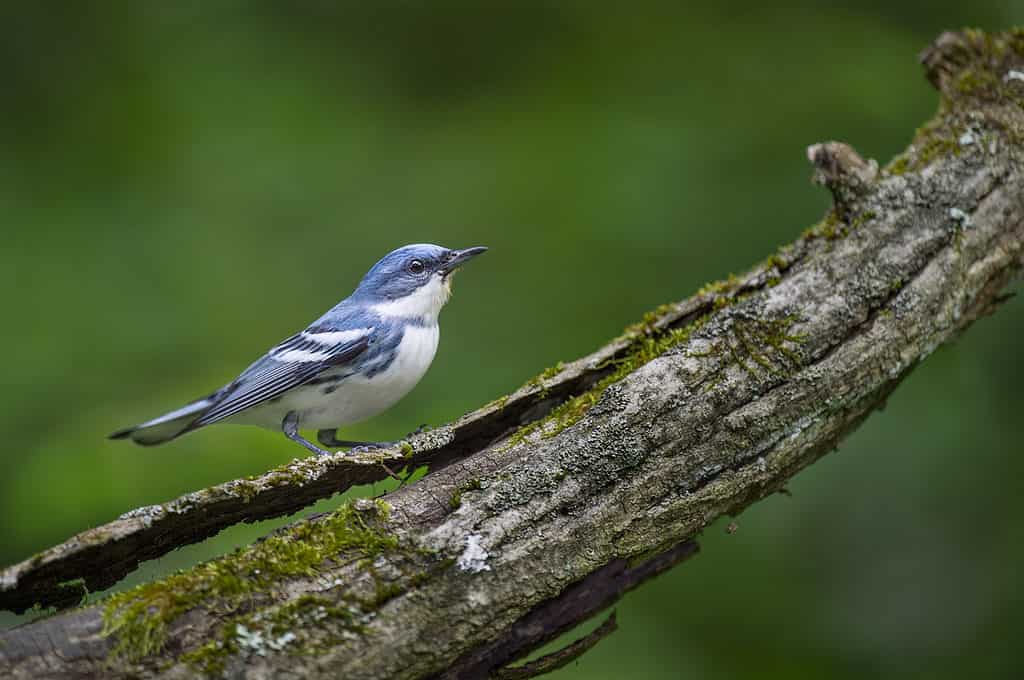
Cerulean warblers are occasional migrants through South Carolina, stopping to forage in scrub and forests.
©iStock.com/ps50ace
Migration and Habitat: The cerulean warbler is an occasional migrant through South Carolina and stops to forage in scrub and forests.
Features and Coloring: These birds have small bills and short tails and feature sky blue, white, and black plumage.
Food: They mainly eat insects.
Vocalizations: Their trills are buzzy and metallic.
Nests: They craft small open cups on horizontal tree branches.
9. Purple Martin
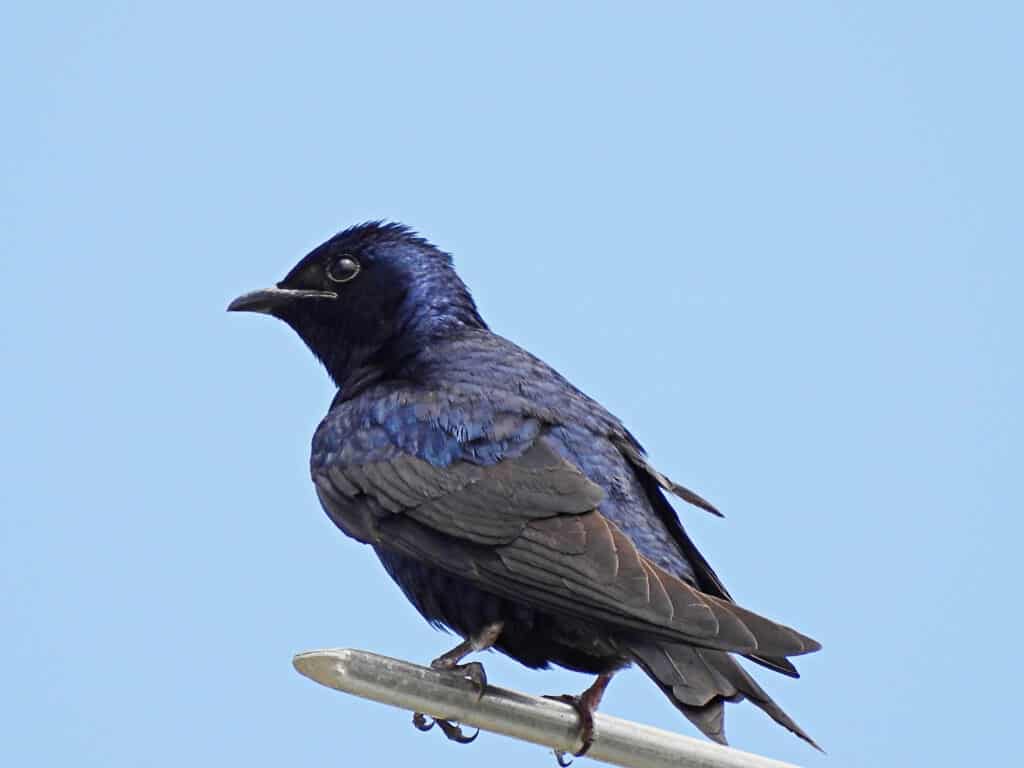
Purple martins have an average wingspan of 15 inches and a length of 7.9 inches.
©iStock.com/passion4nature
Migration and Habitat: Purple martins breed across South Carolina and the rest of the Eastern United States. They once bred along forest edges and rivers but now can be found almost exclusively in suburban and urban areas in nest boxes.
Features and Coloring: This species has long wings, slightly hooked bills, and broad chests. Their coloring is a deep metallic blue-purple and black.
Food: Insects are their main source of food.
Vocalizations: They have throaty croaks and rattles.
Nests: Look for grass and leaf cups in old woodpecker holes.
10. Belted Kingfisher
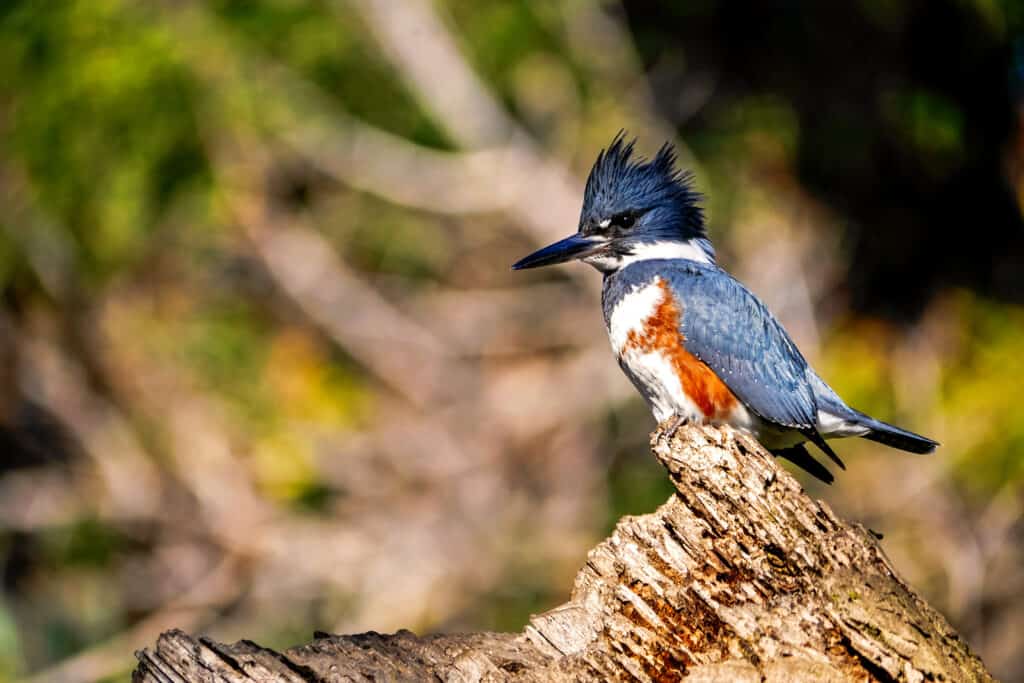
Belted kingfishers live all year in South Carolina and most of the United States. They need water for feeding and nesting.
©Horse Crazy/Shutterstock.com
Migration and Habitat: The belted kingfisher is a permanent resident in South Carolina and throughout most of the United States. These birds must have access to water for feeding. Look for them near lakes, estuaries, rivers, ponds, and streams.
Features and Coloring: These birds have long dagger bills, shaggy crests, and large heads. Their plumage is grayish-blue, white, and chestnut.
Food: Small fish are their food source.
Vocalizations: Listen for their mechanical rattles.
Nests: They build tunnels in vertical banks.
11. Barn Swallow
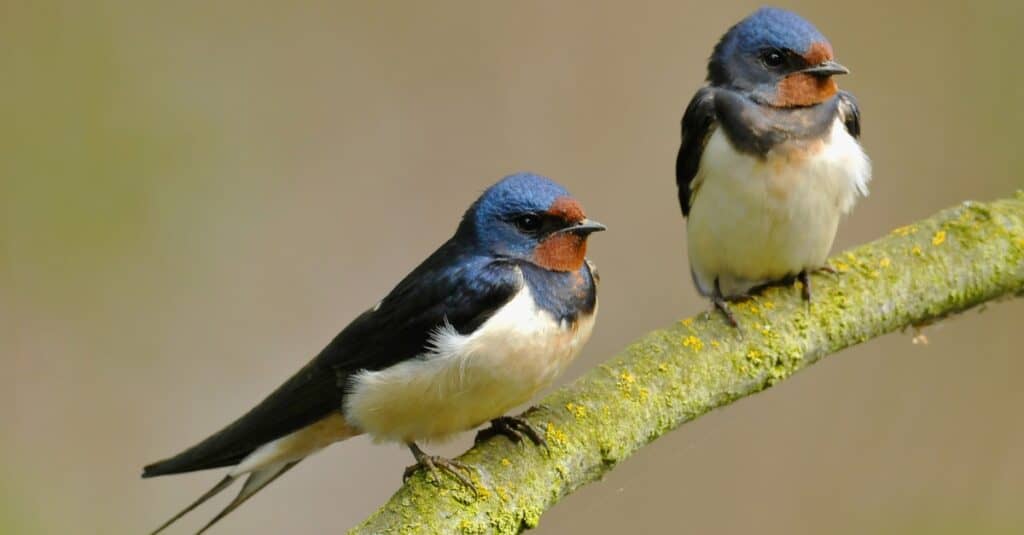
The
barn swallow
is a breeder in South Carolina, primarily away from the coast. They live around farms, fields, ponds, and towns.
©CezaryKorkosz/Shutterstock.com
Migration and Habitat: Barn swallows breed across South Carolina, especially away from the coast. You are likely to find them around farms, fields, ponds, and towns.
Features and Coloring: They have broad shoulders and long wings, featuring dark blue, cinnamon, and tawny plumage.
Food: These birds love to eat insects.
Vocalizations: This species has warbles and mechanical whirs.
Nests: They usually build mud cups under eaves, bridges, and docks.
12. White-Breasted Nuthatch
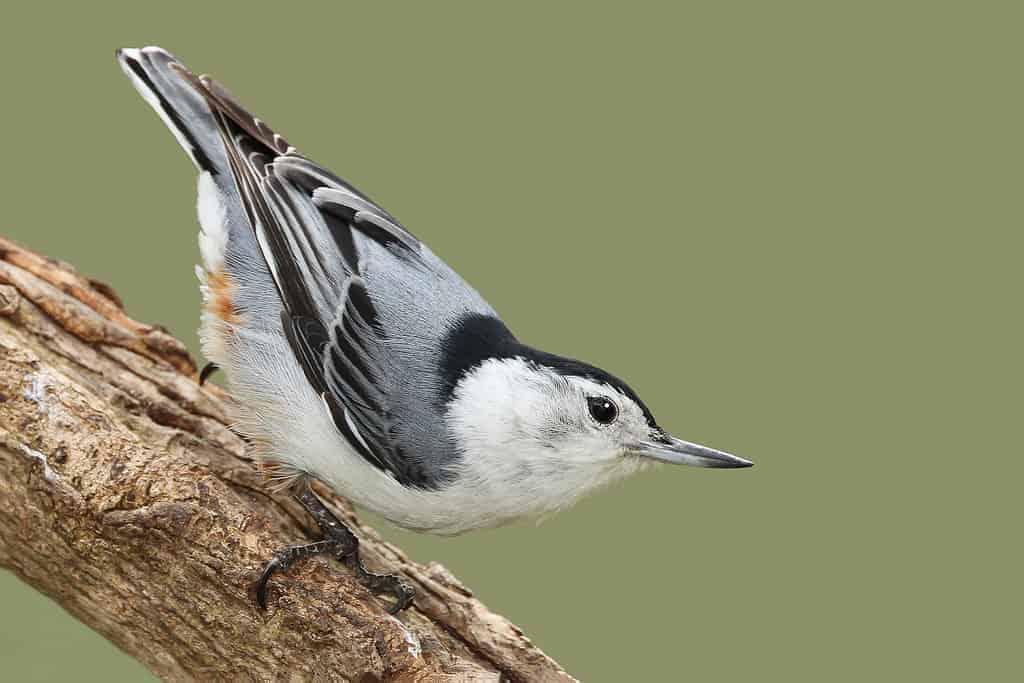
The white-breasted nuthatch is a year-round resident of South Carolina, especially near mature deciduous woods.
©Brian Lasenby/Shutterstock.com
Migration and Habitat: The white-breasted nuthatch lives year-round in South Carolina and a majority of the United States. This species prefers mature woods, specifically deciduous. But you can also spot them in common areas, like parks, yards, and other wooded suburbs.
Features and Coloring: These birds have short tails and long, pointed bills. They feature bluish-gray, black, and white coloring.
Food: Insects and seeds are their favorite treats.
Vocalizations: They have unique low, fast nasally notes.
Nests: A nesting nuthatch builds a simple bark cup in a large tree cavity or old woodpecker hole.
13. Red-Breasted Nuthatch
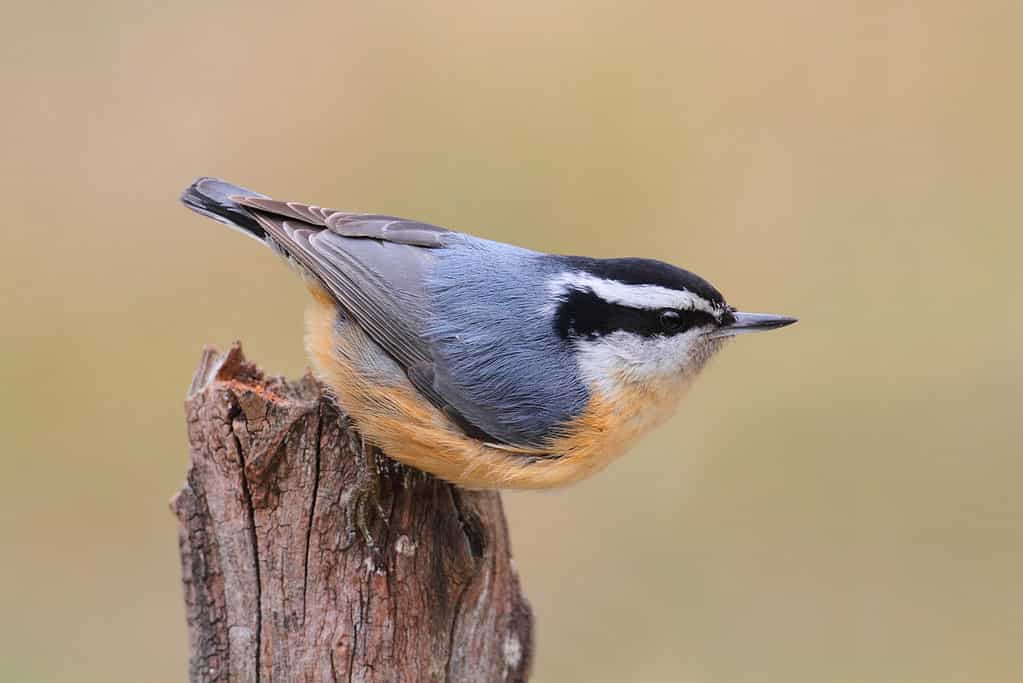
The red-breasted nuthatch winters in South Carolina in coniferous forests and deciduous woods.
©iStock.com/SteveByland
Migration and Habitat: The red-breasted nuthatch spends its winter in South Carolina and across much of the United States. You can find these birds almost exclusively in coniferous forests or deciduous woods.
Features and Coloring: This species has a short tail and a long, pointed bill. Their plumage is bluish-gray, rusty red, black, and white.
Food: They consume insects and seeds.
Vocalizations: Rapid nasal notes are their calling card.
Nests: They form cavities lined with soft grass in rotten stubs.
Summary of 13 Blue Birds in South Carolina
Here’s a recap of the 13 birds with blue coloring found in South Carolina.
| Bird Species | Range | Coloring |
|---|---|---|
| Tree Swallow | Winters along the South Carolina coast and migrates through the rest of the state | Blue-green above and white below; dark brown/almost black wings and tails |
| Eastern Bluebird | Permanent residents in South Carolina and throughout most of the Southeast | Male eastern bluebird has bright blue plumage above and white below with brownish-red breasts |
| Blue Jay | Lives year-round in South Carolina and the rest of the East | Plumage is a mixture of various blue shades, white, and black |
| Indigo Bunting | Breeds throughout South Carolina and most of the Eastern United States | Bright blue feathers all over with darker heads and silver beaks |
| Painted Bunting | Breeds along the South Carolina coast before heading to Southern Florida for the winter | Plumage is vivid and colorful, featuring blue, red, orange, and green |
| Great Blue Heron | Permanent resident in South Carolina and across much of the U.S, especially near southern coasts | Plumage is overall bluish-gray and white |
| Little Blue Heron | Populations along the South Carolina coast stay there year-round, and those further inland live there during the breeding season | Dark grayish-blue and maroon |
| Cerulean Warbler | Occasional migrant through South Carolina and stops to forage in scrub and forests | Sky blue, white, and black plumage |
| Purple Martin | Breed across South Carolina and the rest of the Eastern U.S. | Deep metallic blue-purple and black |
| Belted Kingfisher | Permanent resident in South Carolina and throughout most of the United States | Plumage is grayish-blue, white, and chestnut |
| Barn Swallow | Breed across South Carolina, especially away from the coast | Dark blue, cinnamon, and tawny plumage |
| White-Breasted Nuthatch | Lives year-round in South Carolina and a majority of the U.S. | Bluish-gray, black, and white coloring |
| Red-Breasted Nuthatch | Spends its winter in South Carolina and across much of the United States | Plumage is bluish-gray, rusty red, black, and white |
The photo featured at the top of this post is © iStock.com/passion4nature
Thank you for reading! Have some feedback for us? Contact the AZ Animals editorial team.



